Impact of UV Exposure and Incidence of Merkel Cell Carcinoma Between 1990 and 2018 in Austria
Abstract
Simple Summary
Abstract
1. Introduction
2. Methods
3. Results
3.1. Staging
3.2. Incidence
3.3. UV Data
3.4. Correlation Analysis Between UV Radiation and Incidence
3.5. Survival
4. Discussion
5. Conclusions
Supplementary Materials
Author Contributions
Funding
Institutional Review Board Statement
Informed Consent Statement
Data Availability Statement
Conflicts of Interest
References
- Toker, C. Trabecular carcinoma of the skin. Arch. Dermatol. 1972, 105, 107–110. [Google Scholar] [CrossRef]
- Erovic, I.; Erovic, B.M. Merkel Cell Carcinoma: The Past, the Present, and the Future. J. Ski. Cancer 2013, 2013, 1–6. [Google Scholar] [CrossRef] [PubMed]
- Haymerle, G.; Janik, S.; Fochtmann, A.; Pammer, J.; Schachner, H.; Nemec, L.; Mildner, M.; Houben, R.; Grasl, M.C.; Erovic, B.M. Expression of Merkelcell polyomavirus (MCPyV) large T-antigen in Merkel cell carcinoma lymph node metastases predicts poor outcome. PLoS ONE 2017, 12, e0180426. [Google Scholar] [CrossRef]
- Erovic, B.M.; Al Habeeb, A.; Harris, L.; Goldstein, D.P.; Ghazarian, D.; Irish, J.C. Significant overexpression of the Merkel cell polyomavirus (MCPyV) large T antigen in Merkel cell carcinoma. Head Neck 2013, 35, 184–189. [Google Scholar] [CrossRef] [PubMed]
- Haymerle, G.; Fochtmann, A.; Kunstfeld, R.; Pammer, J.; Erovic, B.M. Merkel cell carcinoma: Overall survival after open biopsy versus wide local excision. Head Neck 2015, 38, E1014–E1018. [Google Scholar] [CrossRef]
- González-Vela, M.d.C.; Curiel-Olmo, S.; Derdak, S.; Beltran, S.; Santibañez, M.; Martínez, N.; Castillo-Trujillo, A.; Gut, M.; Sánchez-Pacheco, R.; Almaraz, C.; et al. Shared Oncogenic Pathways Implicated in Both Virus-Positive and UV-Induced Merkel Cell Carcinomas. J. Investig. Dermatol. 2017, 137, 197–206. [Google Scholar] [CrossRef] [PubMed]
- Harms, P.; Vats, P.; Verhaegen, M.E.; Robinson, D.R.; Wu, Y.-M.; Dhanasekaran, S.M.; Palanisamy, N.; Siddiqui, J.; Cao, X.; Su, F.; et al. The Distinctive Mutational Spectra of Polyomavirus-Negative Merkel Cell Carcinoma. Cancer Res. 2015, 75, 3720–3727. [Google Scholar] [CrossRef]
- Yu, Z.-W.; Zheng, M.; Fan, H.-Y.; Liang, X.-H.; Tang, Y.-L. Ultraviolet (UV) radiation: A double-edged sword in cancer development and therapy. Mol. Biomed. 2024, 5, 1–24. [Google Scholar] [CrossRef]
- Fidanzi, C.; Troaca, S.F.; Fanelli, G.N.; Romanelli, M.; Dini, V.; Viacava, P.; Marconcini, R.; Morganti, R.; D’erme, A.M.; Bagnoni, G.; et al. Epidemiology of Merkel cell carcinoma in Tuscany (Italy), 2006–2021. Eur. J. Cancer Prev. 2023, 32, 298–300. [Google Scholar] [CrossRef]
- Kieny, A.; Cribier, B.; Meyer, N.; Velten, M.; Jégu, J.; Lipsker, D. Epidemiology of Merkel cell carcinoma. A population-based study from 1985 to 2013, in northeastern of France. Int. J. Cancer 2018, 144, 741–745. [Google Scholar] [CrossRef]
- Jackson, P.C.; Wallis, K.; Allgar, V.; Lind, M.J.; Stanley, P.R. Merkel cell carcinoma in East Yorkshire: A case series and literature review of current management. J. Plast. Reconstr. Aesthetic Surg. 2015, 68, 667–672. [Google Scholar] [CrossRef]
- Doyle, C.; Brennan, A.; Wolinska, A.; Murphy, L.; O’Mahoney, S.; Blasco, M.C.; Andrawis, M.; Beatty, P.; McFeely, O.; Tobin, A.M. Incidence of Merkel cell carcinoma in the Republic of Ireland (1994–2019). Int. J. Dermatol. 2023, 62, e423–e424. [Google Scholar] [CrossRef]
- Vanicek, K.; Frei, T.; Lyinska, Z.; Schmalwieser, A. UV Index for the Public; Publication of the European Communities: Brussels, Belgium, 2000. [Google Scholar]
- Zaar, O.; Gillstedt, M.; Lindelöf, B.; Wennberg-Larkö, A.; Paoli, J. Merkel cell carcinoma incidence is increasing in Sweden. J. Eur. Acad. Dermatol. Venereol. 2016, 30, 1708–1713. [Google Scholar] [CrossRef] [PubMed]
- Kukko, H.; Böhling, T.; Koljonen, V.; Tukiainen, E.; Haglund, C.; Pokhrel, A.; Sankila, R.; Pukkala, E. Merkel cell carcinoma—A population-based epidemiological study in Finland with a clinical series of 181 cases. Eur. J. Cancer 2012, 48, 737–742. [Google Scholar] [CrossRef] [PubMed]
- Reichgelt, B.; Visser, O. Epidemiology and survival of Merkel cell carcinoma in the Netherlands. A population-based study of 808 cases in 1993–2007. Eur. J. Cancer 2011, 47, 579–585. [Google Scholar] [CrossRef] [PubMed]
- Youlden, D.; Soyer, H.P.; Youl, P.H.; Fritschi, L.; Baade, P. Incidence and Survival for Merkel Cell Carcinoma in Queensland, Australia, 1993–2010. JAMA Dermatol. 2014, 150, 864–872. [Google Scholar] [CrossRef]
- Kaae, J.; Hansen, A.V.; Biggar, R.J.; Boyd, H.A.; Moore, P.S.; Wohlfahrt, J.; Melbye, M. Merkel Cell Carcinoma: Incidence, Mortality, and Risk of Other Cancers. J. Natl. Cancer Inst. 2010, 102, 793–801. [Google Scholar] [CrossRef]
- Office of National Statistics. Deaths Involving COVID-19 by Local Area and Socioeconomic Deprivation: Deaths Occurring Between 1 March 2020 and 31 July 2020; Statistical Bulletin, ONS: London, UK, 2020.
- Moll, R.; Löwe, A.; Laufer, J.; Franke, W.W. Cytokeratin 20 in human carcinomas. A new histodiagnostic marker detected by monoclonal antibodies. Am. J. Pathol. 1992, 140, 427–447. [Google Scholar]
- Hanau, C.A.; Miettinen, M. Solitary fibrous tumor: Histological and immunohistochemical spectrum of benign and malignant variants presenting at different sites. Hum. Pathol. 1995, 26, 440–449. [Google Scholar] [CrossRef]
- Moll, R.; Moll, I.; Franke, W.W. Identification of Merkel cells in human skin by specific cytokeratin antibodies: Changes of cell density and distribution in fetal and adult plantar epidermis. Differentiation 1984, 28, 136–154. [Google Scholar] [CrossRef]
- Feng, H.; Shuda, M.; Chang, Y.; Moore, P.S. Clonal Integration of a Polyomavirus in Human Merkel Cell Carcinoma. Science 2008, 319, 1096–1100. [Google Scholar] [CrossRef]
- Koepke, P.; De Backer, H.; Bais, A.; Curylo, A.; Eerme, K.; Feister, U.; Johnsen, B.; Junk, J.; Kazantzidis, A.; Krzyscin, J.; et al. EUR 23338—COST Action 726—Modelling Solar UV Radiation in the Past: Comparison of Algorithms and Input Data; Office for Official Publications of the European Communities: Luxembourg, 2006. [Google Scholar]
- Blumthaler, M. UV Monitoring for Public Health. Int. J. Environ. Res. Public Health 2018, 15, 1723. [Google Scholar] [CrossRef]
- Tetzlaff, M.T.; Nagarajan, P. Update on Merkel Cell Carcinoma. Head Neck Pathol. 2018, 12, 31–43. [Google Scholar] [CrossRef]
- Erdem, B.Y.; Baykal, C.; Ozluk, Y.; Ahmed, M.A.; Kozanoglu, E.; Saip, P.; Buyukbabani, N.; Sari, S.O. Evaluating CK20 and MCPyV Antibody Clones in Diagnosing Merkel Cell Carcinoma. Endocr. Pathol. 2025, 36, 1. [Google Scholar] [CrossRef] [PubMed]
- Haluza, D.; Simic, S.; Moshammer, H. Temporal and Spatial Melanoma Trends in Austria: An Ecological Study. Int. J. Environ. Res. Public Health 2014, 11, 734–748. [Google Scholar] [CrossRef] [PubMed]
- Monshi, B.; Vujic, M.; Kivaranovic, D.; Sesti, A.; Oberaigner, W.; Vujic, I.; Ortiz-Urda, S.; Posch, C.; Feichtinger, H.; Hackl, M.; et al. The burden of malignant melanoma—Lessons to be learned from Austria. Eur. J. Cancer 2016, 56, 45–53. [Google Scholar] [CrossRef] [PubMed]
- Seidl-Philipp, M.; Frischhut, N.; Höllweger, N.; Schmuth, M.; Nguyen, V.A. Known and new facts on basal cell carcinoma. JDDG J. Dtsch. Dermatol. Ges. 2021, 19, 1021–1041. [Google Scholar] [CrossRef]
- Lugowska, I.; Becker, J.C.; Ascierto, P.A.; Veness, M.; Blom, A.; Lebbe, C.; Migliano, E.; Hamming-Vrieze, O.; Goebeler, M.; Kneitz, H.; et al. Merkel-cell carcinoma: ESMO-EURACAN Clinical Practice Guideline for diagnosis, treatment and follow-up. ESMO Open 2024, 9, 102977. [Google Scholar] [CrossRef]
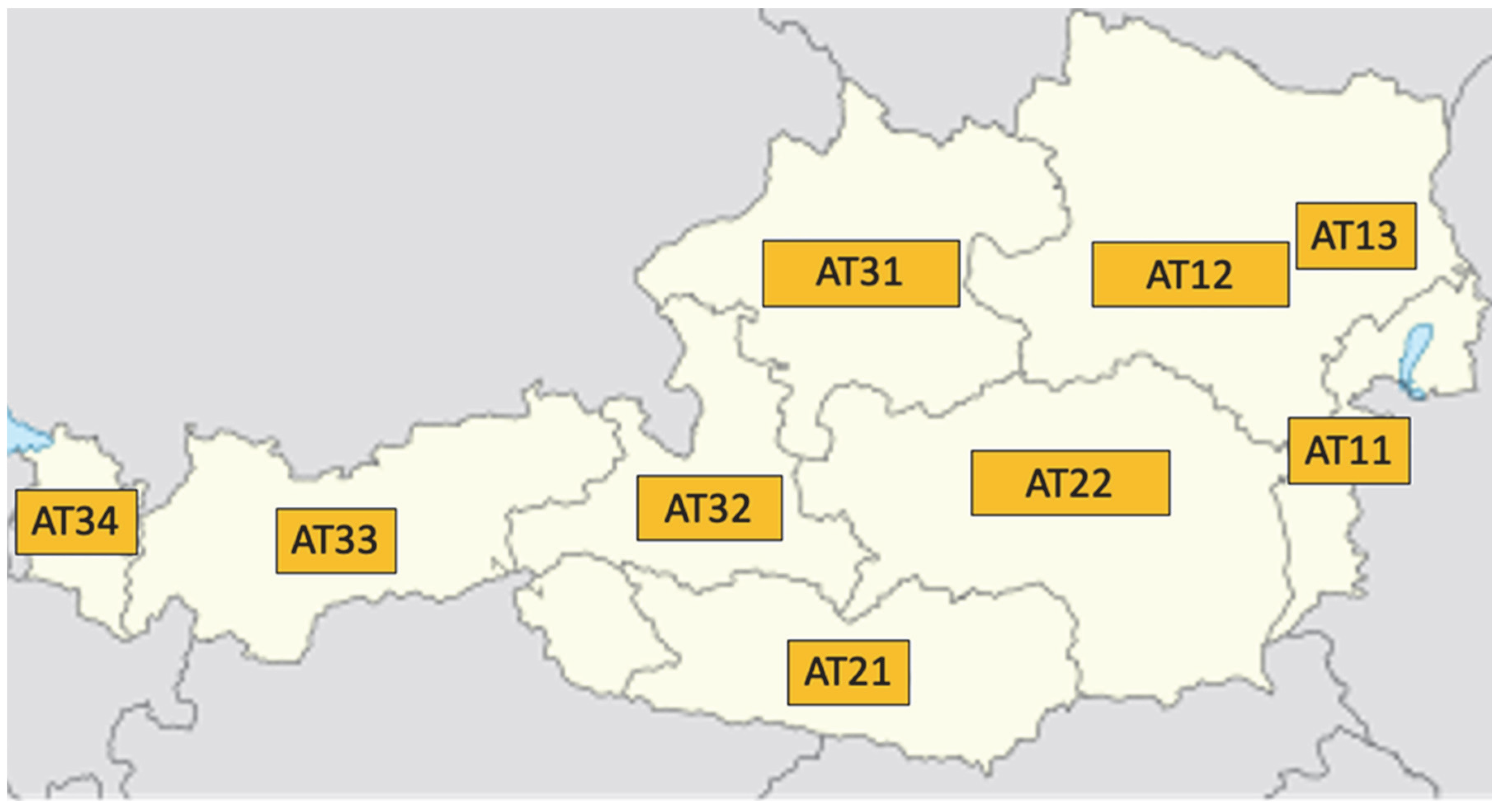
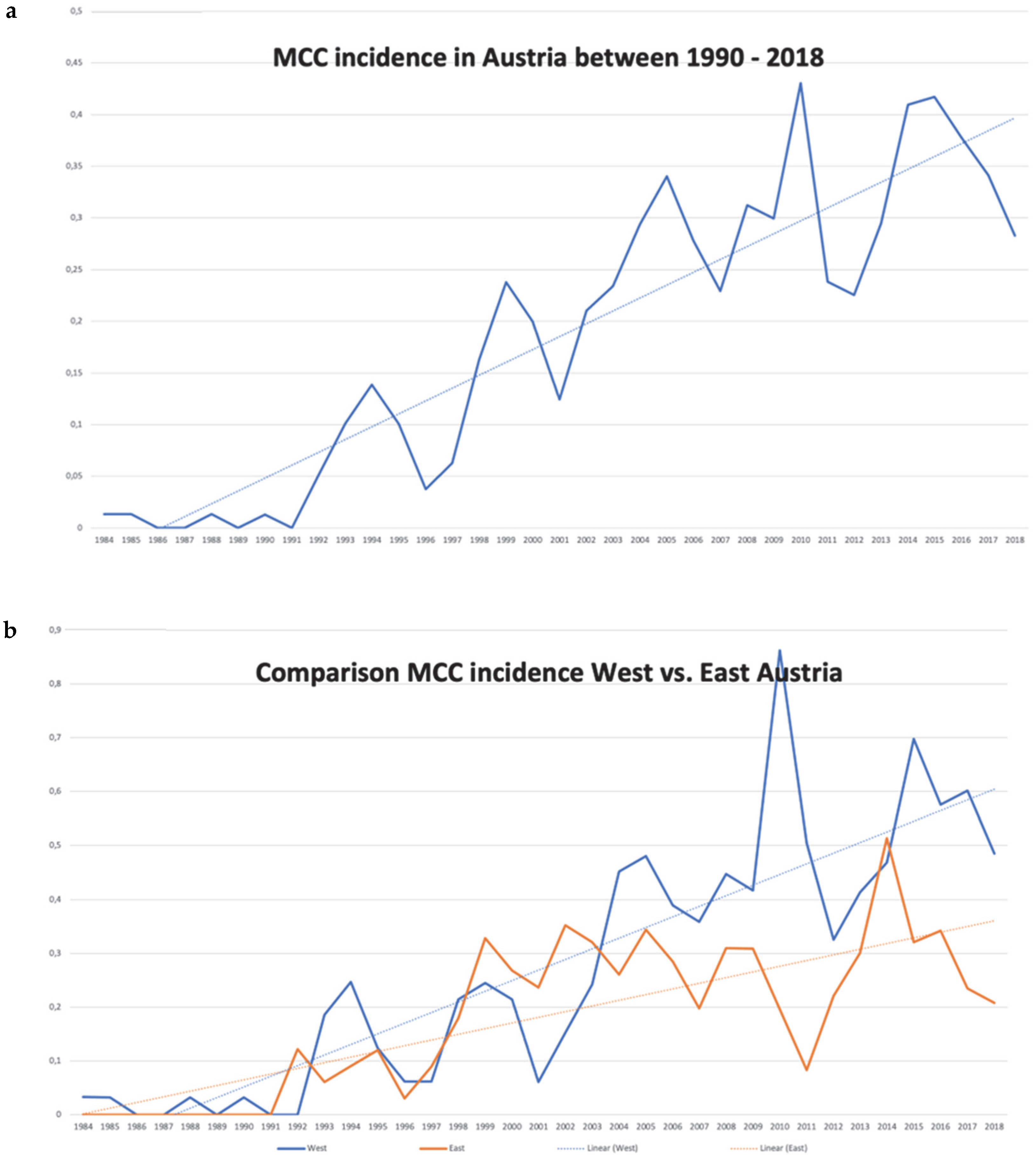
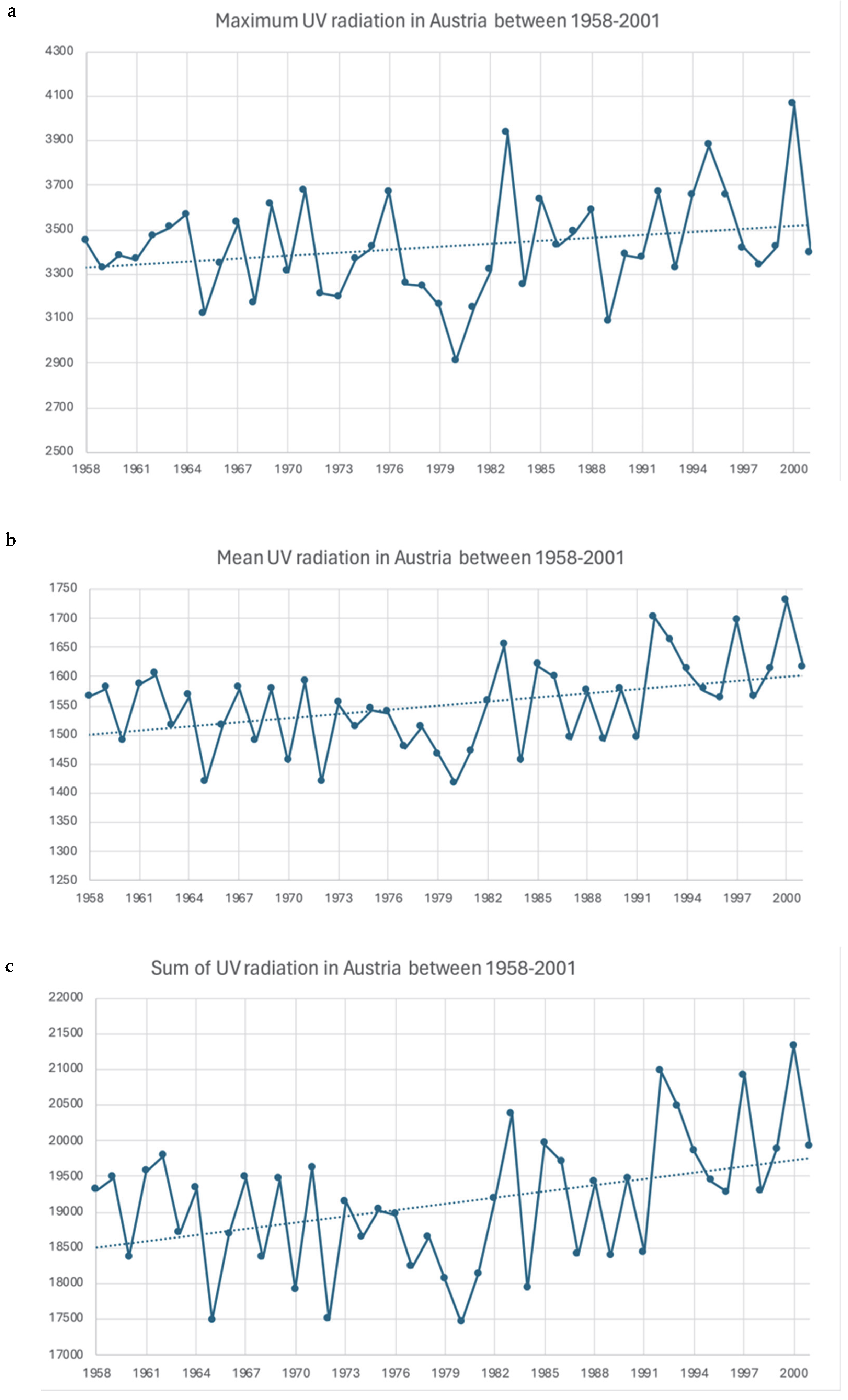
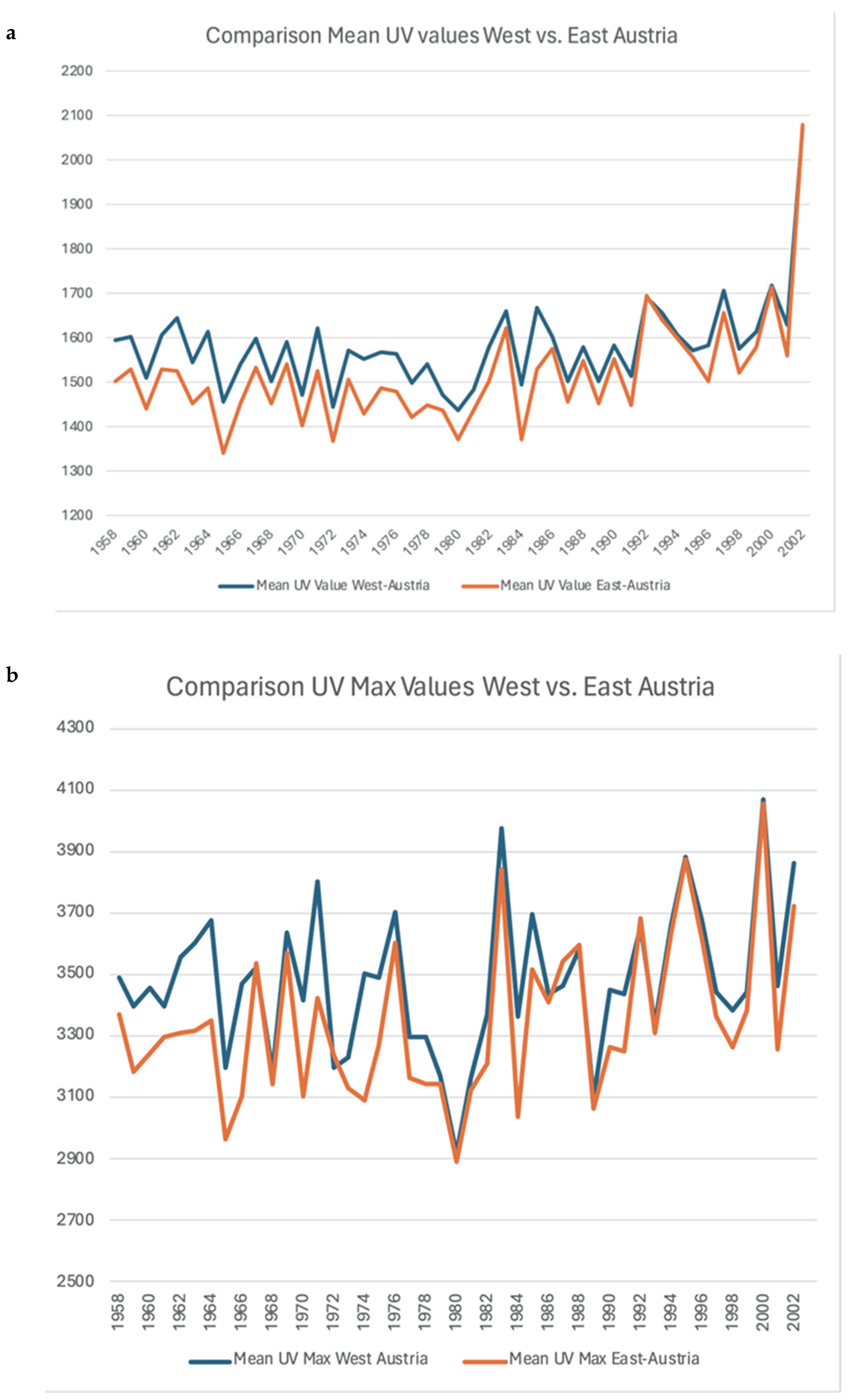
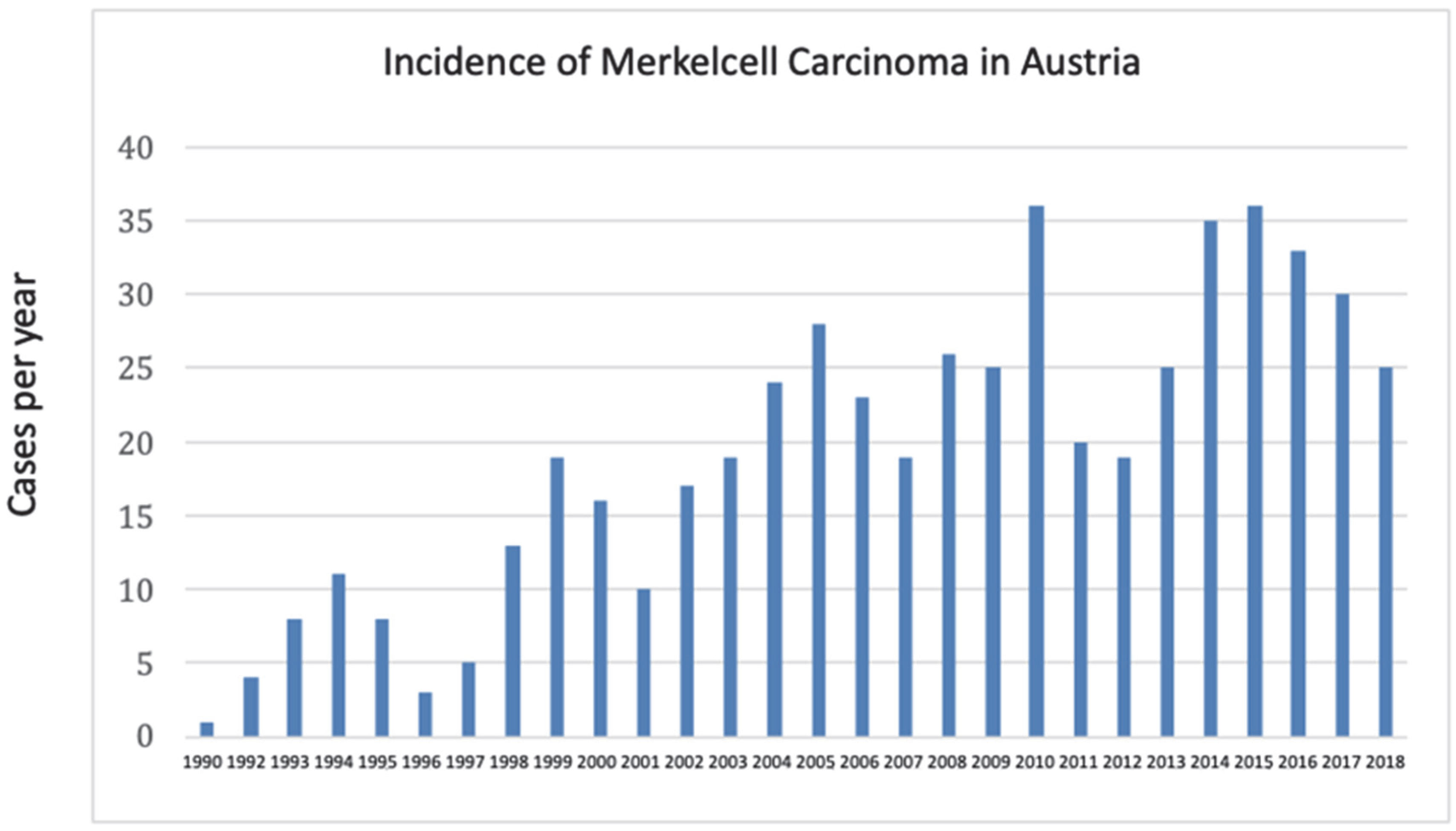
| Year of Diagnosis | Number of Patients |
|---|---|
| 1984 | 1 |
| 1985 | 1 |
| 1988 | 1 |
| 1990 | 1 |
| 1992 | 4 |
| 1993 | 8 |
| 1994 | 11 |
| 1995 | 8 |
| 1996 | 3 |
| 1997 | 5 |
| 1998 | 13 |
| 1999 | 19 |
| 2000 | 16 |
| 2001 | 10 |
| 2002 | 17 |
| 2003 | 19 |
| 2004 | 24 |
| 2005 | 28 |
| 2006 | 23 |
| 2007 | 19 |
| 2008 | 26 |
| 2009 | 25 |
| 2010 | 36 |
| 2011 | 20 |
| 2012 | 19 |
| 2013 | 25 |
| 2014 | 35 |
| 2015 | 36 |
| 2016 | 33 |
| 2017 | 30 |
| 2018 | 25 |
| Variables | n (%) |
|---|---|
| Gender | 538 (100) |
| Female | 314 (58.4) |
| Male | 224 (41.6) |
| Age distribution | |
| Older than 50 | 531 (98.7) |
| Older than 80 | 217 (40.3) |
| FNA vs. Biopsy | |
| FNA | 10 (1.9) |
| Biopsy | 504 (93.7) |
| Not known | 24 (4.5) |
| Tumor localization | |
| Not known | 162 (30.1) |
| Head/Neck | 204 (37.9) |
| Upper extremities | 73 (13.6) |
| Lower extremities | 65 (12.1) |
| Trunk | 33 (6.1) |
| Overlapping regions | 1 (0.2) |
| N-Classification | |
| Nx | 230 (42.8) |
| N0 | 172 (55.8) |
| N+ | 136 (44.2) |
| M-classification | |
| Mx | 230 (42.8) |
| M0 | 264 (85.7) |
| M+ | 44 (14.3) |
| Annual Mean UV Radiation (J/m2) | Highest Monthly UV Radiation of the Year (J/m2) | |
|---|---|---|
| Minimum | 1416.49 | 2909.93 |
| Maximum | 1729.40 | 4062.28 |
| Mean | 1552.85 | 3428.57 |
| Standard Deviation | 74.84 | 228.72 |
| Standard Error of Mean | 11.28 | 34.48 |
| Western (J/m2) | Eastern (J/m2) | p-Value | ||
|---|---|---|---|---|
| Maximum | 3478.25 | 3347.25 | <0.001 | |
| Standard Deviation | 234.03 | 252.61 | ||
| Standard Error | 34.89 | 37.66 | ||
| 95% CI | 3409.9–3546.6 | 3273.4–3421.1 | ||
| Mean | 1581.60 | 1517.84 | <0.001 | |
| Standard Deviation | 101.77 | 119.36 | ||
| Standard Error | 15.17 | 17.79 | ||
| 95% CI | 1551.9–1611.3 | 1483.0–1552.7 |
Disclaimer/Publisher’s Note: The statements, opinions and data contained in all publications are solely those of the individual author(s) and contributor(s) and not of MDPI and/or the editor(s). MDPI and/or the editor(s) disclaim responsibility for any injury to people or property resulting from any ideas, methods, instructions or products referred to in the content. |
© 2025 by the authors. Licensee MDPI, Basel, Switzerland. This article is an open access article distributed under the terms and conditions of the Creative Commons Attribution (CC BY) license (https://creativecommons.org/licenses/by/4.0/).
Share and Cite
Erovic, B.M.; Schmalwieser, A.; Seemann, R.; Schwabel, F.; Grasl, S.; Janik, S.; Grasl, M.C. Impact of UV Exposure and Incidence of Merkel Cell Carcinoma Between 1990 and 2018 in Austria. Cancers 2025, 17, 3379. https://doi.org/10.3390/cancers17203379
Erovic BM, Schmalwieser A, Seemann R, Schwabel F, Grasl S, Janik S, Grasl MC. Impact of UV Exposure and Incidence of Merkel Cell Carcinoma Between 1990 and 2018 in Austria. Cancers. 2025; 17(20):3379. https://doi.org/10.3390/cancers17203379
Chicago/Turabian StyleErovic, Boban M., Alois Schmalwieser, Rudolf Seemann, Florian Schwabel, Stefan Grasl, Stefan Janik, and Matthaeus C. Grasl. 2025. "Impact of UV Exposure and Incidence of Merkel Cell Carcinoma Between 1990 and 2018 in Austria" Cancers 17, no. 20: 3379. https://doi.org/10.3390/cancers17203379
APA StyleErovic, B. M., Schmalwieser, A., Seemann, R., Schwabel, F., Grasl, S., Janik, S., & Grasl, M. C. (2025). Impact of UV Exposure and Incidence of Merkel Cell Carcinoma Between 1990 and 2018 in Austria. Cancers, 17(20), 3379. https://doi.org/10.3390/cancers17203379







